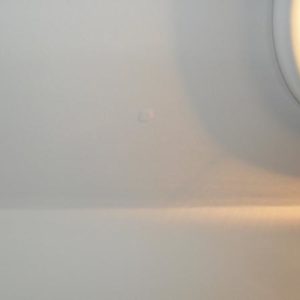Hello everybody,
First of all, sorry because my english it’s not very good.
We had a problem in a house,
After some months of finishing it, we have seen several points on the walls,
where the head of the screw has pushed and you can see a little bump on the wall.
Do you know what is the problem?
Thanks in advance.
Mario




















Replies
Drying out
Your studs are drying out and moving causing what we call nail pops. Could also be the stucture settling. All normal in the industry. Leave things for a year or so then repair. A lot of contractors will give you a one year call back warranty for just what you are experiencing. Not out of the norm
Gary
As mentioned, that is a nail/screw pop.
When your house was built, the lumber used was hopefully around 19% moisture content. It's probably closer to 5% now. With reduced moisture, the wood fibers shrink across the short faces (not the long). So a wood stud that is 3 an 1/2" thick when it is placed and covered with drywall may about be 3 and 3/8" thick today. That's 1/8" thinner. Unfortunatly the fasteners used don't shrink with the wood, they will always be the same length. But when the wood shrinks on the outside, the inside where the point rests stays about in the same place, this leaves the screw/nail higher than when it was set during the build.
Yep, "nail pops" (or "screw
Yep, "nail pops" (or "screw pops" now, since they use mostly screws for drywall now). It's not unusual to have a few in a new house (maybe 5-10 per room at the worst), but it's not good if you're seeing a lot of them. And, as was stated, a good contractor will be willing to send someone to fix them after a year or so -- after things have "stabilized" fairly well. (Also, most painters will be able/willing to fix them for little if any additional charge when they paint a room.)
thanks
Hello,
I want to thank you all for your help,
I forgot to say that I'm not a customer, I'm a contractor in Spain
and apreciatte very much your advice. We always want to fix problems
to our customers and improve our methods. In this situation we
didn't know what was happening, but now we already now a little more.
Thanks again!
Mario
One thing to keep in mind is that using screws/nails that are too long can make the "pops" worse. Since they are caused primarily by shrinkage of the wood, a longer screw or nail will penetrate more wood and "see" more shrinkage. You want to limit the screw penetration into the wood to no more than 1.5" (38mm). (This limit is also used in the US to avoid striking wiring, which is required to be at least that far back from the wood surface.)
Drywall
Hi DanH,
We are using 35mm screws and 13mm drywall, I think it isn't very long in my opinion.
Do you think that if we use 15mm drywall could solve the problem?
Thanks very much.
13mm is a half inch -- pretty much standard in the US for normal residential walls. Using thicker drywall isn't likely to do much either way in terms of screw pops.
Again, a few screw pops are almost inevitable. There will be variations based on the time of year, amount of humidity during construction, how well seasoned the wood is, etc. The wrong combination of conditions could possibly result in several dozen pops in a 2000 sq ft (186 sq m) home. "Normal" would be 5-10. "Lucky" would be none.
A couple solutions
For what you are experiencing now, there is only one solution that I am aware of. As stated above, give the lumber some time to dry out, then fix it. I use a putty knife to scrape the bup off, then give the screw another half turn to make sure it is deep enough and then spackle and try to match the texture if enough of the wall was disturbed.
To avoid this in the future, there are some options, though sometimes screw pops are inevitable. You can use a slightly shorter screw, and that will help reduce the pops. The second option is to wait for the lumber to dry out, though that is not always feasable when others are waiting for the drywall guys to get done. In my own house, I made sure to use lumber that was dry, and due to other obligations, I didn't get to drywall until the house had been closed up and dry (with the furnace on) for almost 6 months. after 6 months, I put up vapor barrior and drywalled, and we had zero screw pops. I realize that this is not always possible, but it might help you to explain to your customers why the problem exists. Most customers are pretty happy if you can explain why something happened, and that it will be fixed.
If you are getting LOTS of screw pops, you may not have had the drywall tight against the framing members.